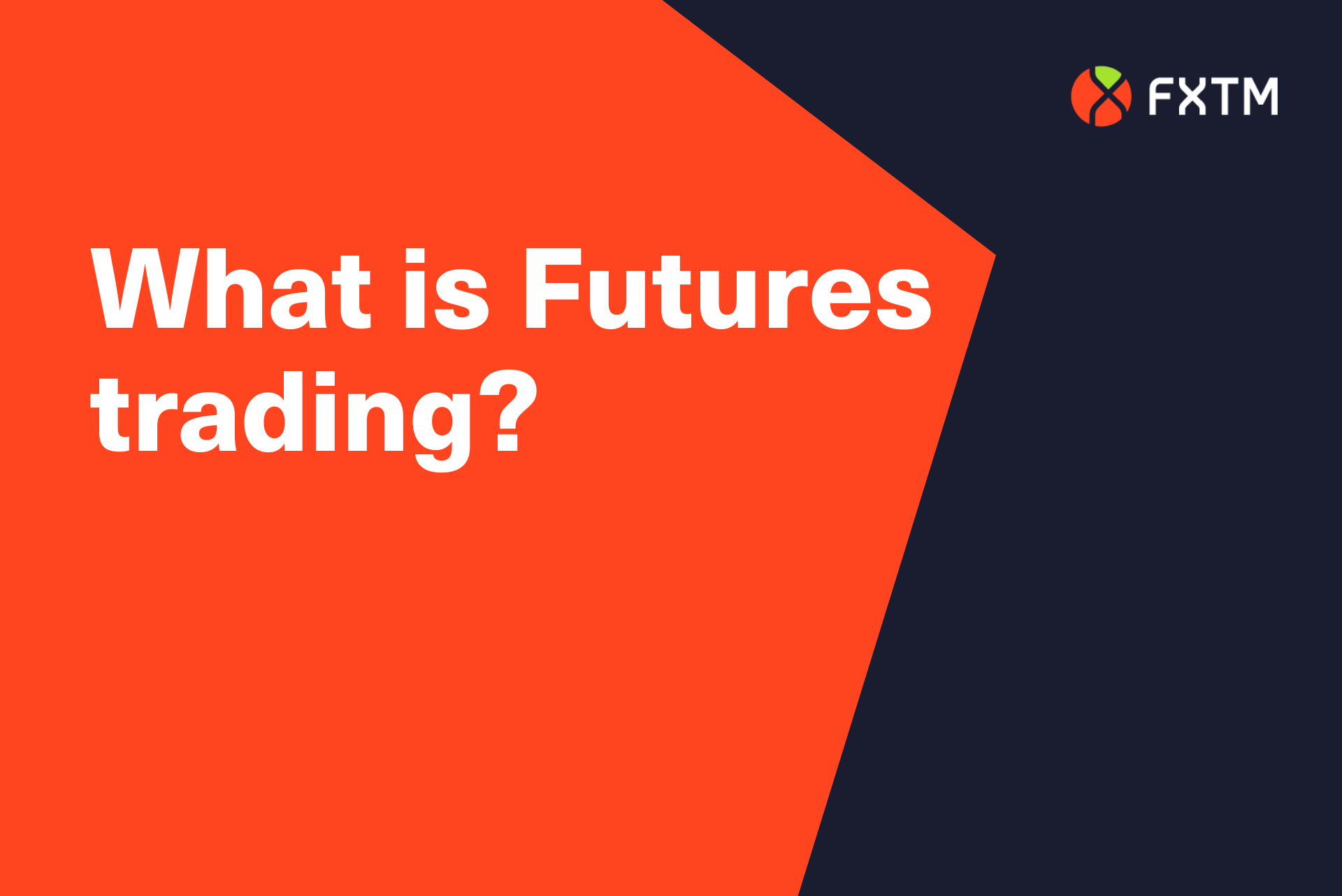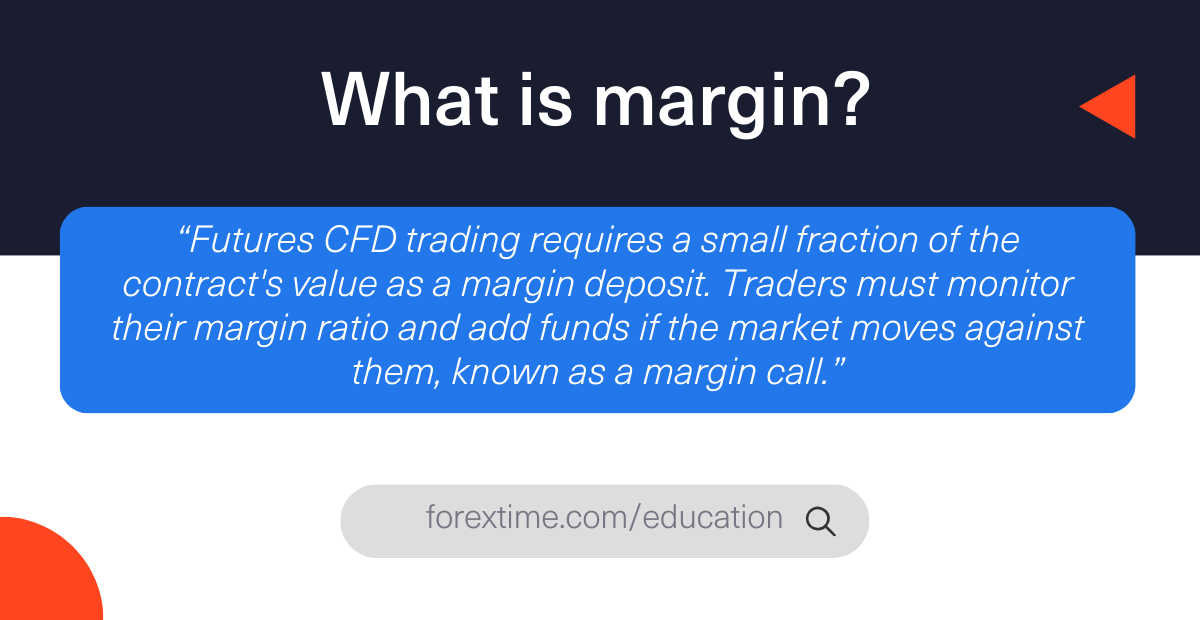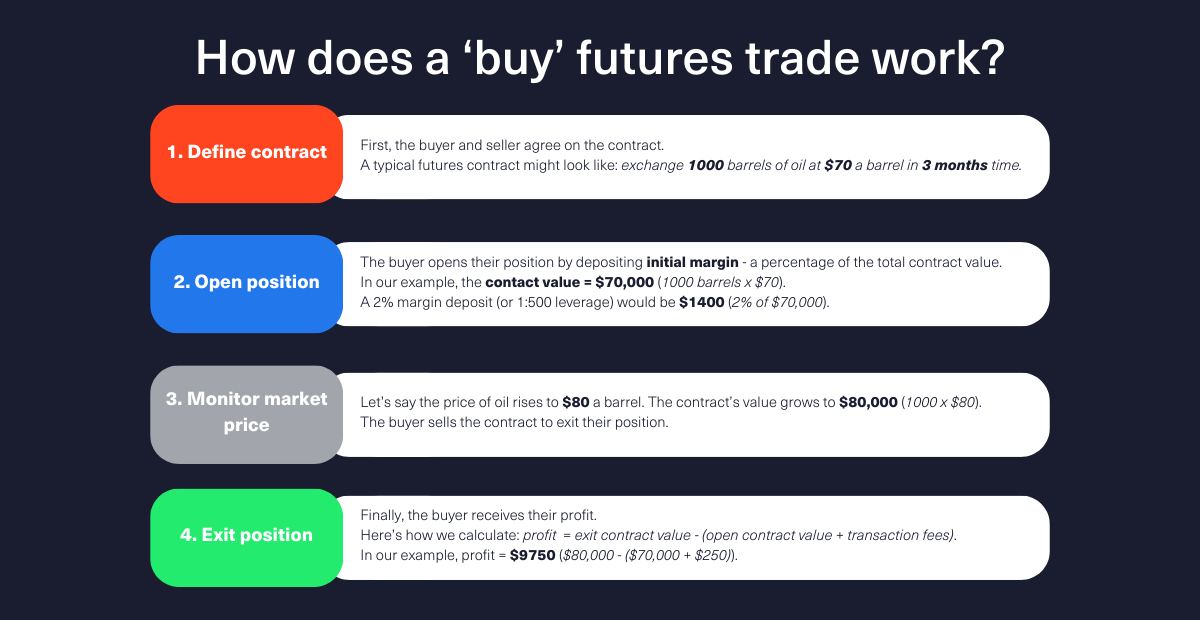What Is Futures trading?

Contract size? Expiration date? Futures trading might sound complex, but once you understand the basics, it's quite simple.
Trading futures is a popular strategy among traders looking to hedge against price fluctuations or speculate on market movements.
In this comprehensive guide, we'll explore the ins and outs of futures trading, including its history, mechanics, benefits, risks, and strategies, to help you get to grips with trading futures.
Introduction to Futures trading
What are Futures contracts?
Put simply, a futures contract is an agreement between two parties to buy or sell a commodity, currency, or financial instrument at a specified price on a future date.
Unlike options and forward contracts, futures are standardised and traded on exchanges, making them more accessible and transparent.
Commonly traded futures include commodities like crude oil, gold, and agricultural products, as well as financial instruments like stock indices and currencies. This standardisation allows for easy trading and reduces counterparty default risk, a significant advantage over forward contracts.
Brief history of Futures trading
Futures trading has origins dating back to ancient civilizations.
Back then, farmers would agree to sell their crops at a later date to secure a stable price - giving them more security over the days and months to come.
Modern futures trading began in the 19th century with the Chicago Board of Trade (CBOT), which standardised contracts for agricultural products.
Over time, futures trading expanded into financial markets, including currencies, interest rates, and stock indices, reflecting the growing complexity of the global economy.

Key features of Futures trading
To get to grips with futures trading, there are a few key terms you'll need to know:
- Contract size
- Expiration date
- Margin requirements
Contract size
Futures contracts have a specific contract size, which is how much of the underlying asset or financial instrument that must be bought or sold when the contract expires.
For example, a standard gold futures contract on the Chicago Mercantile Exchange (CME) represents 100 ounces of gold. This allows for easy price comparison between different contracts and ensures sufficient liquidity in the market.
Expiration date
Futures contracts also have an expiration date, which is the last day on which the contract can be traded before exchanged or settled.
Typically, futures contracts expire monthly or quarterly, depending on the exchange and underlying asset.
As an expiration date approaches, traders must either close their position or roll over their contract to the next expiration date.
Margin requirements
Finally, to trade futures, traders must deposit an initial margin, which is a fraction of the total value of the contract.
This acts as an ironclad agreement to ensure that both parties can fulfill their obligations in case the market moves in an unexpected (or unwanted) direction.
Maintaining this margin requires monitoring and potentially adding additional funds if the market moves unfavourably - known as margin calls.

How Futures trading works
As we covered, trading futures involves taking a position on the future price of an asset.
If the price rises, you can sell the contract at a higher price and make a profit.
On the other hand, if you believe that the price of gold will decrease, you could sell (or "short") a futures contract.
If the price does fall, you can buy back the contract at a lower price and make a profit.
Unlike traditional stock trading where investors purchase ownership in a company, futures trading is purely based on speculation and market timing.
Here's how it works.
Market participants
Futures markets comprise speculators and hedgers.
Speculators aim to profit from price fluctuations, while hedgers use futures to protect against adverse price movements in their underlying assets.
Both institutional and retail traders participate in futures markets, contributing to their liquidity and depth.
Standardisation
To help facilitate the exchange of futures contracts, they are also standardised in terms of quantity, quality, and delivery time.
For example, a crude oil futures contract on the New York Mercantile Exchange (NYMEX) specifies 1,000 barrels of oil, ensuring consistency and transparency for traders.
Physical v cash settlement
Futures contracts can be settled physically or in cash.
Physical settlement involves the actual delivery of the underlying asset, while cash settlement only involves the exchange of cash based on the contract's value at expiration.
Traders typically choose cash-settled contracts to avoid the logistics of physical delivery.
Example of a Futures trade
Ok, now we know the main components of a futures trade, here's how it all comes together.
Suppose you believe the price of crude oil will rise. You could buy a crude oil futures contract at $70 per barrel, anticipating a price increase.
If the price rises to $80 per barrel before the contract expires, you'd sell the contract, pocketing the $10 per barrel difference as profit.

For more on the details of futures trading, including a step-by-step guide, check out our guide on how to trade futures.
Benefits of Futures Trading
Now that we understand how futures trading works, let's explore some of its key benefits:
- Risk management and hedging
Futures trading offers an effective way to manage risk and hedge against price volatility.
For example, airlines can buy futures contracts to lock in fuel prices, protecting themselves against rising costs.
Similarly, farmers can sell futures contracts to secure a stable price for their crops, reducing the impact of unpredictable market conditions.
- High liquidity and market efficiency
Futures markets are highly liquid, enabling traders to enter and exit positions quickly.
This liquidity, combined with transparent pricing, ensures market efficiency and reduces the likelihood of price manipulation.
- Diversification opportunities
Futures trading allows investors to diversify their portfolios by gaining exposure to various asset classes.
By incorporating commodities, currencies, and stock indices, traders can reduce risk and enhance returns.
Risks involved in futures trading
- High leverage risk
While leverage can amplify profits, it also increases the potential for significant losses.
A small adverse price movement can result in a margin call, requiring additional funds to maintain the position. It's essential to understand leverage and use it responsibly.
- Market volatility
Futures markets can experience significant price swings due to factors such as geopolitical tensions, economic data releases, and natural disasters.
Traders must be prepared for these fluctuations and implement strategies to manage risk effectively.
- Counterparty and systemic risks
Although futures exchanges mitigate counterparty risk through daily settlements and margin requirements, systemic risks can still arise.
Traders should carefully select brokers and exchanges to minimise these risks.
Popular markets for Futures trading
Commodity Futures
Commodity futures provide exposure to markets such as agriculture (e.g., wheat, corn), energy (e.g., crude oil, natural gas), and metals (e.g., gold, silver).
These markets are influenced by various factors, including weather, geopolitics, and supply and demand dynamics.
Financial Futures
Financial futures include index futures, currency futures, and bond futures.
These instruments allow traders to hedge against interest rate fluctuations, currency exchange rate changes, and stock market movements.
With FXTM, you can trade some of the world's most popular stock indices as futures CFDs.
Diversify your trades and hedge open positions with leverage up to 1:1000. Remember, trading with leverage can increase your losses, too.
Futures trading strategies
Successful futures trading requires skill, knowledge, and a well-developed strategy.
You'll also need to be aware of common pitfalls of futures trading. Here are some popular strategies to consider:
Day trading Futures
Day trading involves buying and selling futures contracts within the same trading day, capitalising on short-term price movements.
While this strategy can be profitable, it requires constant monitoring and quick decision-making.
Key lookouts for day trading Futures
- Market analysis and timing
Successful day trading hinges on thorough market analysis. Traders should use a combination of technical indicators and chart patterns to anticipate price movements.
Having a strong grasp of market trends and being able to react quickly to changes is crucial in make the most of profitable opportunities.
- Risk management and discipline
Implementing strict risk management practices is essential in day trading futures.
This includes setting stop-loss orders to limit potential losses and not over-leveraging positions. Maintaining discipline in adhering to your trading plan and avoiding emotional decision-making can protect your investment and ensure long-term success.
- Liquidity and volatility awareness
Be mindful of the market’s liquidity and volatility. High liquidity allows for quick entry and exit from trades, while volatility creates opportunities for profit.
However, excessive volatility can also increase risk, so it's important to stay informed about market conditions and news events that could impact price movements.
Swing trading Futures
Swing trading focuses on capturing price moves over several days or weeks, using technical indicators to identify trends and entry/exit points.
This medium-term strategy offers more flexibility than day trading and requires less frequent monitoring.
Key lookouts for swing trading futures
- Trend analysis and identification
A key aspect of swing trading is the ability to identify and follow prevailing trends.
Traders should utilise a mix of technical analysis tools like moving averages, trend lines, and oscillators to determine the market's direction.
Recognising whether a market is trending upwards, downwards, or sideways helps in making informed trading decisions.
- Entry and exit point precision
Successfully timing your market entries and exits can significantly impact the profitability of swing trades.
Use verified patterns and signals such as support and resistance levels, Fibonacci retracements, and breakouts to determine optimal entry and exit points.
Precise timing can help maximise profits and minimise risks associated with market reversals.
- Patience and emotional resilience
Unlike day trading, swing trading requires patience as trades may take several days or weeks to reach their potential.
Stay composed during market fluctuations and avoid reacting impulsively to market noise. Developing emotional resilience ensures adherence to your trading strategy and prevents emotional decision-making during volatile times.
Hedging with Futures
Hedging involves using futures contracts to protect investment portfolios from adverse price movements.
For example, an investor holding a stock portfolio may buy index futures to offset potential losses during a market downturn.
Key lookouts for hedging with Futures
- Understanding portfolio needs
Clearly define your portfolio’s specific requirements and risks. Assess which assets need protection and determine the extent of coverage required.
Deciding the appropriate contracts and quantities is crucial to successfully mitigate risk without over-hedging, ensuring the hedging strategy aligns with overall investment goals.
- Correlation analysis
Perform thorough correlation analysis between the futures contracts and underlying assets.
A strong positive or negative correlation ensures that the futures effectively hedge against price movements.
By understanding the relationship between assets, you can select futures contracts that will offer optimal protection and balance.
- Regular review and adjustment
Consistently review and adjust your hedging positions as market conditions and portfolio compositions change.
Monitoring market trends and economic indicators allows for timely adjustments, ensuring the hedging strategy remains relevant and effective over time.
This proactive management can safeguard against unforeseen risks and optimise portfolio performance.
Getting started with Futures trading
Futures trading offers opportunities for significant gains, but it also involves substantial risks.
It's important to approach futures trading with a well-informed and disciplined mindset.
Here are some essential steps to get you started:
- Selecting a broker
Choose a reputable broker that offers competitive pricing, advanced trading platforms, educational resources, and reliable customer support.
With FXTM, you can trade futures as CFDs, avoiding any swap fees and giving you more control over your position size and leverage.
You also won't need to worry about expiry dates as your position will rollover automatically (for a small rollover fee).
- Have a plan
Once you've familiarised yourself with the fundamentals of futures trading, including costs, contract specifications, margin requirements, and market regulations, you'll need to make a plan.
A successful trading plan should outline your goals, risk tolerance, and preferred strategies. Establishing a clear plan helps maintain discipline and manage emotions during volatile market conditions.
- Practice on Demo accounts
Before trading with real money, consider using a simulated demo account to practice and refine your strategies. Paper trading allows you to gain experience without risking capital, helping build confidence and competence.
The bottom line
Futures trading offers numerous opportunities for profit, risk management, and diversification.
By understanding the mechanics, benefits, and risks, you can make informed decisions and harness the power of futures trading to achieve your financial goals.
Remember to educate yourself continually and trade responsibly, prioritising risk management and ethical practices. With persistence and discipline, you can unlock the potential of futures trading and secure a prosperous financial future.
Ready to trade with real money?
Open accountPut your knowledge to the test
Start trading with a leading broker that gives you more.
